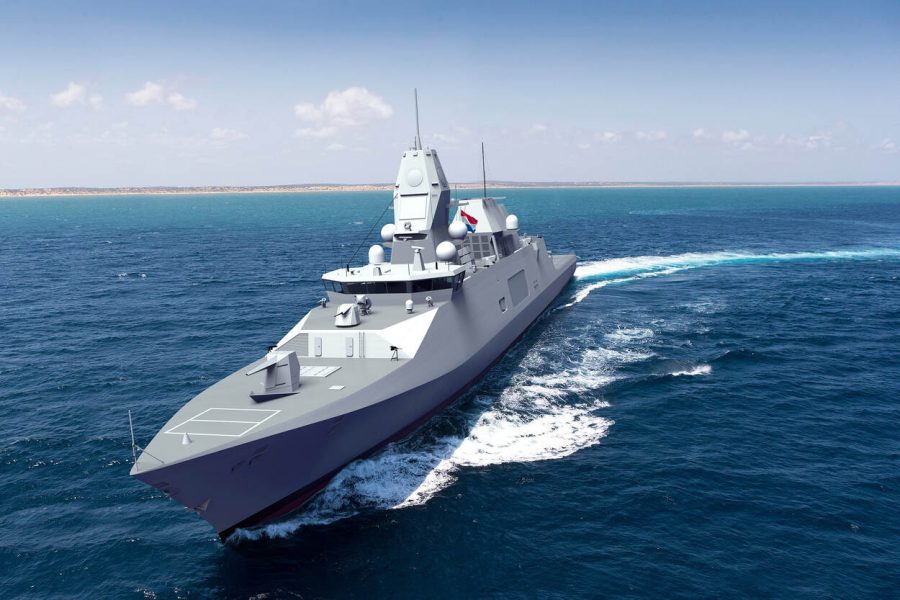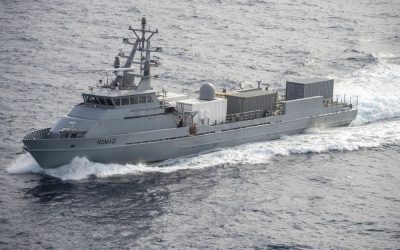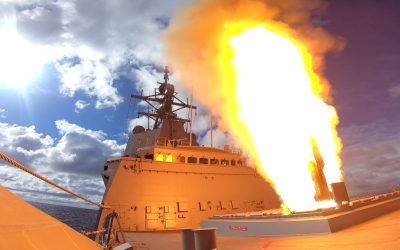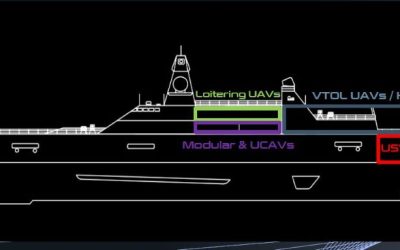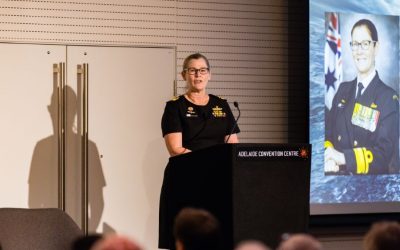The Netherlands and Belgium are embarking on the construction of a new class of frigates primarily intended for anti-submarine warfare and other roles.
The Netherlands Ministry of Defence – through the Materiel and IT Command (Commando Materieel en IT – COMMIT) – has awarded the Naval Division of Damen Shipyards Group a contract for the design, construction and delivery of a new class of Anti-Submarine Warfare Frigate (ASWF) for the Dutch and Belgian navies.
A second contract has been awarded by COMMIT to Thales Nederland for the supply of the ships’ Above Water Warfare System (AWWS) fire control cluster and associated sensor suite.
Under these parallel contracts, signed on board the joint support ship HNLMS Karel Doorman in Den Helder on 29 June 2023, the Royal Netherlands Navy and the Belgian Maritime Component will each receive two ASWF ships to replace their existing M-class multipurpose frigates.
While primarily intended for anti-submarine warfare (ASW), the new ships will also be equipped for anti-surface warfare (offensive and defensive) and anti-air warfare (self-defence).
Development history
The Royal Netherlands Navy and the Belgian Naval Component currently each operate two M-frigates. All four ships have previously received a major mid-life Improvement Programme (IP-MF) intended to sustain their capability to end-of-life. The IP-MF introduced a new combat management system (based on the Guardion CMS software core); a new upper mast structure accommodating the Thales Nederland Seastar surface search radar and Gatekeeper panoramic electro-optical surveillance system; the Thales UK-supplied APX radar electronic support measures; a replacement RH Marine platform management system; and adaptations to enable the operation of an NH90 helicopter.
The two Dutch ships also received a low frequency active sonar (LFAS) known as the Multistatic Active Passive System (MAPS). The MAPS system combines signal processing and display software developed by TNO with towed active transmit and passive array elements supplied by Ultra Maritime and TNO.
However, the M-frigates ships were commissioned between and are now in need of replacement. The governments of the Netherlands and Belgium in November 2016 signed a Letter of Intent on bilateral cooperation covering mine countermeasures (MCM) and frigates, with a formal Memorandum of Understanding (MoU) following in June 2018. Under this MoU arrangement, Belgium is leading on the acquisition of a next-generation MCM capability to meet the combined needs of the two navies, with the Netherlands taking the responsibility for the procurement of two new frigates for each service.
Agreement was reached on the general characteristics of the ASWF design back in mid-2020 following a period of design reconciliation involving a series of cost/capability trade-offs. At this stage, the design activity had determined a vessel displacing approximately 5,500tonnes.
However, as the detailed design was matured during the contract preparation phase, it was found that the baseline design would need to grow in size (by approximately 8m) to accommodate requirements for underwater radiated noise, shock, stability and through-life margins.
Attendant cost growth – driven by both amendments to the design and wider price inflation – demanded intensive negotiations with industry (both for the platform and combat system) and subsequent budgetary approvals in both the Dutch House of Representatives and Belgium’s Council of Ministers. The two governments in April 2023 announced that they had reached agreement to acquire the four ASWF frigates at a total cost approaching €4 billion (US$4.2 billion).
Platform aspects
The ASWF will have a full load displacement of around 6,400tonnes, an overall length of 145m, beam of 18m, and a draught of 5.5m. A hybrid diesel-electric propulsion arrangement has been selected is intended to allow for ultra-quiet ASW operations. The diesel engines will meet the latest emission requirements.
Increased automation will mean the ships have a core crew of 117 (compared to 153 in an M-frigate) plus spare berths for up to 35 additional personnel (for example, an NH90 helicopter flight or an anti-piracy detachment). Accommodation will be of a high standard, with no more than four people per cabin (against a maximum of nine in the current M-frigate).
The hulls will be built at Damen’s shipyard in Galați, Romania, with construction activity expected to start in 2025. Following launch, each frigate will then be moved to Damen’s facilities in Vlissingen, in the south of the Netherlands, for outfitting and integration of the weapon systems/combat suite. The first ship is planned to enter service with the RNLN in 2029, with the Belgian Maritime Component to receive the second vessel in 2030. All four ships are scheduled for delivery by the end of 2031.
The aviation facilities on board the ASWF will provide for the operation and support of the NH90 helicopter. In addition, the design includes space provisions for small unmanned vessels or air vehicles, and/or a fast intervention craft. To save weight, composites will be used in structures high in the ship. These include the masts, bridge deckhouse and superstructure.
Damen awarded a first major subcontract in early July 2023, with RH Marine contracted to supply the Integrated Mission Management System, the Integrated Navigation Bridge System (INBS), and the Integrated Platform Management System (IPMS) for each of the four frigates.
In the case of the IPMS, the RH Marine solution uses Industrial Internet of Things (IIoT) connectivity, which gives the platform flexibility in connection and configurability. IIoT connectivity, according to the company, also provides the ability to store huge amounts of data from connected systems and sensors (analysis of these data can be used to improve operational processes and support predictive maintenance).
Combat system
The ASWF command and control suite will marry a Guardion combat management system, developed ‘in-house’ by the Joint Informatievoorziening Commando (JIVC), with a new AWWS fire control cluster and sensor suite developed by Thales Nederland. The Guardion CMS will be hosted within the Integrated Mission Management System (as an overarching IT architecture also hosting the INBS and IPMS).
Integrated with, but distinct from, the CMS, the highly automated AWWS has been designed to dynamically select the best defensive response to maximise survivability in stressing combat situations by fully exploiting the full capabilities of all available sensors and subsystems. The sensor suite associated with the AWWS is based on the APAR Block 2 X-band and the SM400 Block 2 S-band radars (each radar comprising four fixed antenna faces.) These will be brought together into a single dual-band X/S-Sensor Suite with integrated suite processing to avoid cueing latencies and enable automatic task sharing/reconfiguration.
An engineering and manufacturing development contract for the AWWS was awarded to Thales Nederland in December 2018. The EMD phase for AWWS is developing the AWWS product, incrementally building functionality, and demonstrating the performance of the X/S-Sensor Suite. EMD will culminate in a critical fire control chain test to demonstrate integration with the Evolved SeaSparrow Missile (ESSM) Block 2 anti-air missile.
In addition to AWWS, Thales has been contracted to supply its Mirador Mk 2 electro-optical fire control sensor, Gatekeeper Mk 2 electro-optic observation sensor, the Scout Mk 3 low detectability naval surveillance radar for the ASWF ships, together with an extensive logistic support package. A separate follow-on contract is planned for the Pharos multi-target tracking radar, which is still in development.
Reflecting its ASW bias, the new ASWF frigates will feature an integrated Under Water Warfare Suite (UWWS) developed under the leadership of TNO. Building on TNO’s experience from the earlier MAPS programme, the UWWS will combine a suite of sonars – towed array, hull-mounted, and mine/obstacle avoidance – plus a torpedo launcher system for the US-built MK 54 lightweight torpedo, and a soft-kill torpedo countermeasures system. A hard-kill anti-torpedo torpedo system is also planned in due course.
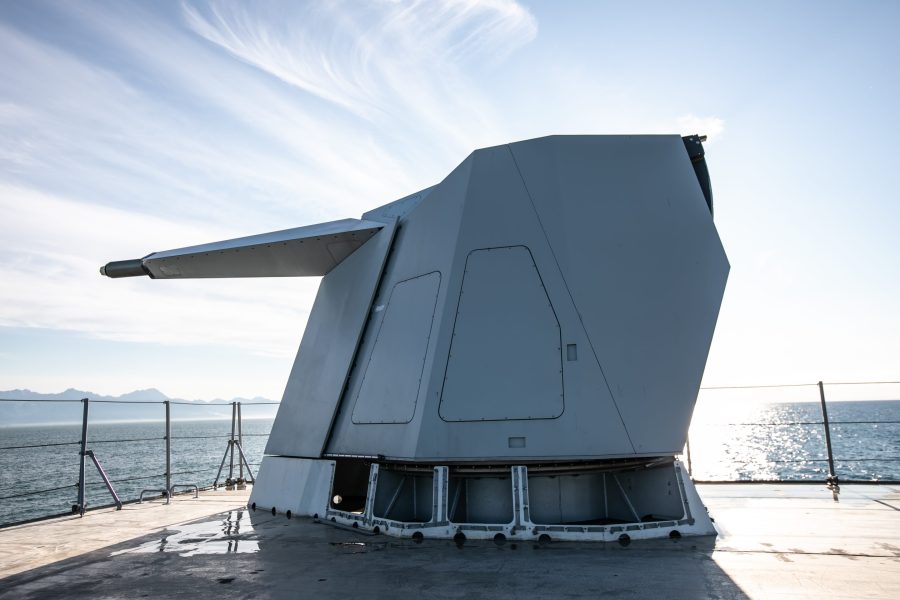
Each ASWF will be fitted with a single Leonardo 76/62 Sovraponte lightweight medium-calibre gun
The NH90 helicopter will also be an important contributor to the frigates’ ASW capability. The Royal Netherlands Air Force’s 806 Squadron at De Kooy operates 11 NFH90 variants – equipped with the HELRAS dipping sonar and lightweight torpedoes – on behalf of the Royal Netherlands Navy.
Each ASWF will be fitted with a single Leonardo 76/62 Sovraponte lightweight medium-calibre gun. Designed for use against air, surface and land targets, the Sovraponte gun is around 30% lighter than the 76/62 Super Rapid mounting, and does not penetrate below deck.
As well as standard rounds, the Sovraponte gun can fire DART (Driven Ammunition with Reduced Time of Flight) guided ammunition for defence against stressing air targets (guidance for DART will be provided by the Pharos multi-target tracking radar).
Local area air defence against air attack will be provided by the ESSM Block 2 missile. Building on the pedigree of the earlier Block 1 missile already in service with the Royal Netherlands Navy, ESSM Block 2 introduces a dual-mode seeker that supports both active radar homing and semi-active radar homing (the active seeker supports terminal engagement without requiring target illumination by the launch ship).
Each ASWF ship will be fitted with two eight-cell MK 41 Baseline VII strike length launcher modules (each cell can take an ESSM Block 2 missile quad-pack for a maximum outload of 64 missiles). A Foreign Military Sales case for the government-to-government acquisition of MK 41 was approved by the US State Department in mid-2023.
A single 21-cell Mk 49 Guided Missile Launching System for RIM-116C Rolling Airframe Missiles will be fitted aft. For close-in defence against small surface targets, the ASWF will be equipped with a number of remote-control weapon stations. Provisions in the design are intended to enable the retrofit of a High Energy Laser weapon at a later stage.
Kongsberg’s Naval Strike Missile (NSM) will provide an offensive anti-surface warfare capability for the ASWF. NSM is already on order for the Royal Netherlands Navy’s four De Zeven Provinciën-class air defence and command frigates, replacing the current Harpoon Block II missile.
